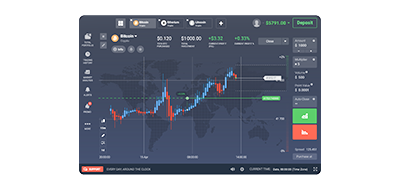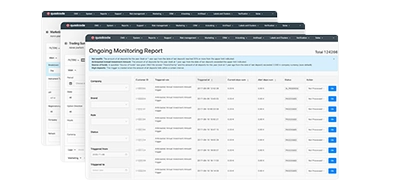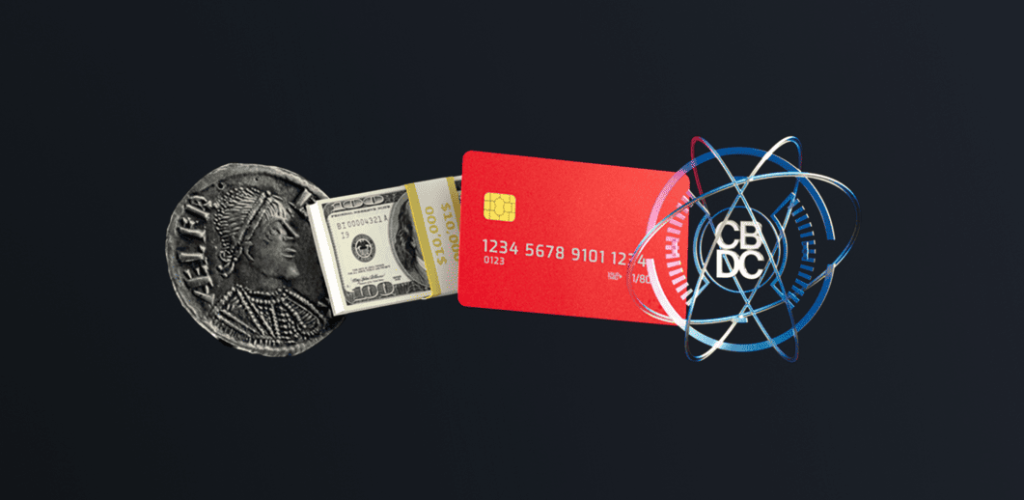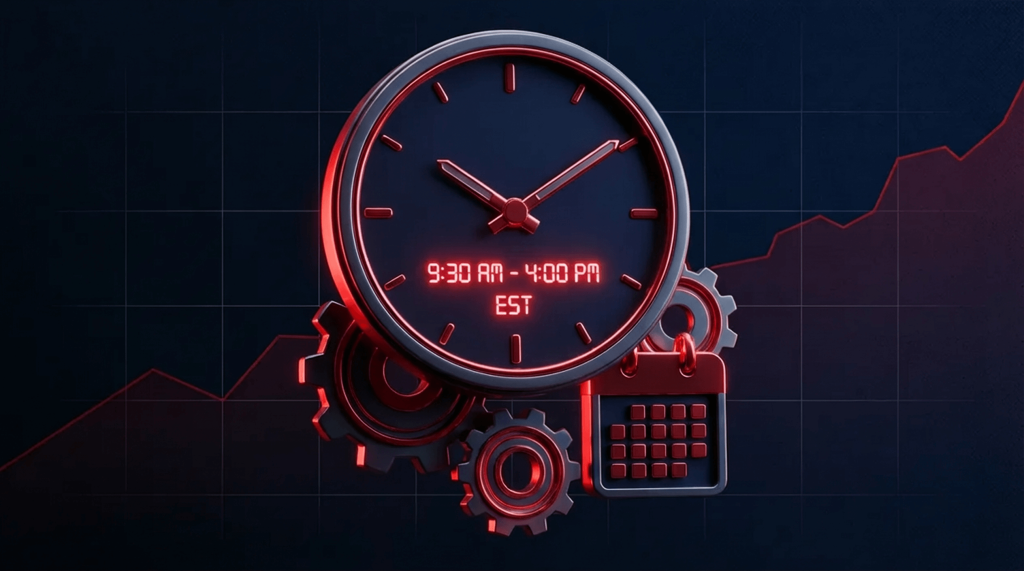Back
Contents
Объяснение сроков действия приказов: определение и типы
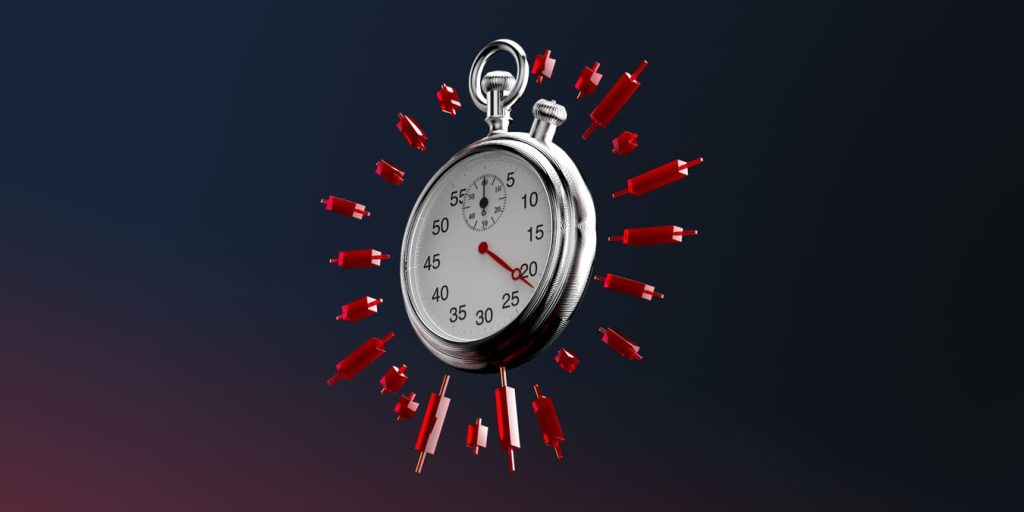

Vitaly Makarenko
Chief Commercial Officer

Demetris Makrides
Senior Business Development Manager
Ордера с ограничением по времени относятся к категории автоматизированных инструментов, которые позволяют трейдерам указывать некоторые предварительные условия своих сделок, в соответствии с которыми эти ордера остаются активными до момента их исполнения или истечения срока действия.
Основные выводы:
- Что такое приказ о временном истечении срока действия?
- Виды приказов о временном прекращении действия?
- Примеры приказов о временном ограничении действия.
- Где и как установить время вступления приказа в силу?
- Плюсы и минусы приказов о временном прекращении действия.
Эта категория ордеров помогает трейдерам эффективно управлять своими позициями, минимизируя возможные риски. Давайте подробнее рассмотрим, что такое ордер «время в ордере» (TIF) и какие типы ордеров наиболее полезны на разных рынках.
Что означает TIF в трейдинге?
Начинающие трейдеры, делающие первые шаги на финансовых рынках, знакомы с основными типами ордеров: рыночными и лимитными. Профессиональные же трейдеры выходят за рамки базовых ордеров, понимая ценность времени. Эти базовые ордера содержат ряд специфических вариаций, позволяющих трейдерам указывать периоды времени, в течение которых ордер остаётся активным, прежде чем будет исполнен или отменён.
С точки зрения трейдера, время — самый ценный ресурс, который следует использовать правильно. Возможность контролировать время истечения срока действия ордера обеспечивает трейдерам гибкость в реализации торговых стратегий. Ордера TIF позволяют трейдерам адаптироваться к меняющимся рыночным условиям, обеспечивая активность ордеров до того момента, когда открытие позиции станет невыгодным.
Что такое формула TIF?
Категория ордеров TIF включает в себя различные типы ордеров, характеризующиеся определенным набором предварительных условий, особенности исполнения которых зависят от этих предварительных условий.
Типы заказов TIF
Необходимо подробно остановиться на каждом типе ордера TIF, чтобы понять, как функционируют подобные инструменты и почему они популярны среди профессиональных трейдеров.
Дневной заказ
Дневные заказы активны в течение торговый день Только если он останется неисполненным, ордер будет автоматически отменен.
Например, трейдер собирается купить акции TSLA, ожидая падения цены из-за негативных новостей. Он устанавливает лимитную цену и добавляет свой ордер в стакан ордеров. Когда цена актива достигнет указанного уровня, ордер будет исполнен; в противном случае он будет активен до конца торгового дня, а затем автоматически отменён.
Немедленно или отмена (IOC)
Ордера IOC — это инструменты, предписывающие немедленную покупку или продажу актива. Согласно этому типу ордера, любая часть ордера, которая не может быть исполнена немедленно, отменяется.
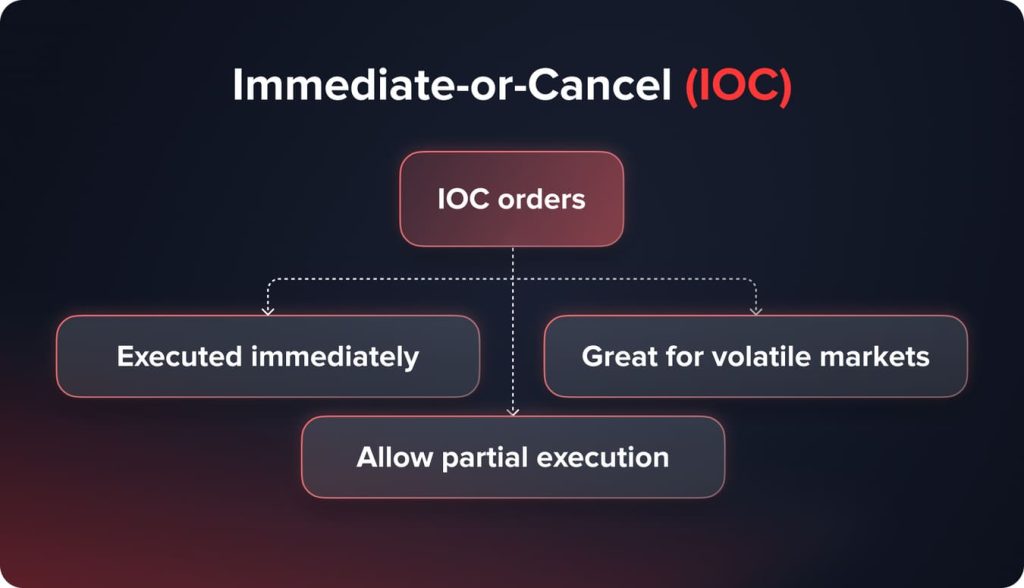
При размещении ордера IOC трейдеры могут задать следующие предварительные условия: цену и объём. Они могут выбрать рыночный или лимитный ордер, а также указать объём актива, который они собираются купить или продать.
Например, трейдеру нужно купить 10 BTC по цене 60 000 долларов. Он размещает ордер «Немедленно или отменить». Тем временем книга заказов может исполнить ордера на 4 BTC по указанной цене. Согласно правилам ордера типа IOC, трейдер получает 4 BTC в свой портфель, а оставшаяся часть ордера отменяется.
Good-till-Cancelled (GTC)
Ордер GTC остаётся активным до тех пор, пока не будет исполнен или отменён. Такой ордер не отменяется автоматически по окончании торгового дня.
Большинство брокеров позволяют трейдерам устанавливать сроки действия ордеров GTC. Обычно они варьируются от 30 до 90 дней. Ордера Good-till-canceled должны исполняться по цене, отличной от текущей рыночной.
Более того, трейдеры часто открывают несколько ордеров GTC, объединяя их в группы взаимной отмены. При исполнении одного ордера остальные автоматически отменяются.
Например, трейдеру необходимо приобрести акции AAPL по цене 220 долларов за акцию, при этом текущая цена актива составляет 229,5 доллара. Трейдеры размещают ордер «Good-till-cancelled», который остаётся активным в течение недель и даже месяцев. Таким образом, трейдерам не нужно постоянно следить за ценами актива, и они могут сосредоточиться на других сделках.
Заполнить или уничтожить (FOK)
Ордера типа «исполнить или отменить» должны быть исполнены немедленно после создания. Важно, чтобы такой ордер был исполнен полностью. Частичное исполнение невозможно. При невозможности полного исполнения ордера типа «исполнить или отменить» отменяются.
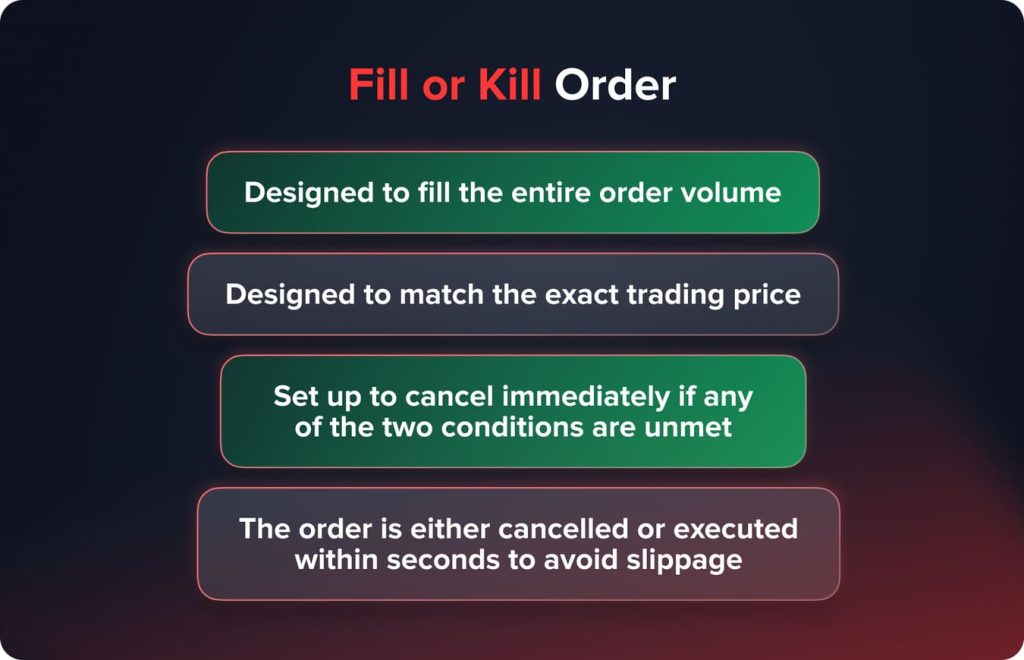
Условия по цене и объёму служат строгими ограничениями. Весь заказ либо соответствует заданным условиям, либо немедленно отменяется.
По сравнению с типом IOC приказы типа «заполнить или уничтожить» являются более строгими, поэтому такие приказы будут выполнены с гораздо меньшей вероятностью.
Например, трейдеру необходимо приобрести 1000 акций определенной корпорации по цене 25 долларов за акцию. Важно немедленно приобрести 1000 акций по указанной цене. В этом случае необходимо открыть ордер «исполнить или аннулировать». Если брокерская компания готова продать 1000 акций по цене 25 долларов, этот ордер будет исполнен. Когда брокерская компания готова продать меньшее количество акций по цене 25 долларов (например, 800 акций), ордер «исполнить или аннулировать» будет отменен.
You may also like

Рынок открыт (МОО)
Ордер «Market-on-open» означает, что позиция будет исполнена по цене открытия дня. Такой ордер может быть исполнен только при открытии рынка или вскоре после его начала. Обратите внимание, что ордера «Market-on-open» могут быть исполнены только по первой опубликованной цене.
Вот процедура работы ордера «Market-on-open»:
- Трейдеры размещают ордера MOO после закрытия рынка. Такие ордера можно создавать вплоть до того момента, когда до открытия рынка остаётся 2 минуты.
- Маркет-мейкеры используют эти 2 минуты, чтобы понять, сколько ордеров MOO размещено и каковы объемы этих ордеров.
- Маркет-мейкеры корректируют свои цены спроса на основе заявок MOO. Таким образом, устанавливается первая опубликованная рыночная цена.
- Ордера Market-on-open исполняются или отменяются в течение первых часов торговой сессии. Точное время зависит от конкретной биржи. Например, NASDAQ исполняет ордера MOO до 9:28 утра (по восточному времени).
Закрытие рынка (MOC)
Ордера «Market-on-Close» (при закрытии рынка) являются противоположностью ордерам MOO. Такие ордера размещаются вблизи цены закрытия рынка или вскоре после окончания торговой сессии. Основная цель ордера MOC — поймать последнюю доступную цену.
Обратите внимание, что ордера «Market-on-Close» доступны только на некоторых рынках и предлагаются только определенными брокерами.
Сроки размещения ордера MOC также зависят от конкретной биржи. Например, на NYSE ордера Market-on-Close можно открывать до 15:50 (ET), но отменить или изменить условия ордера после 15:45 (ET) невозможно.
Как правильно использовать время действия приказов?
Ордера TIF расширяют возможности трейдера, однако важно правильно их использовать. Каковы рекомендации по использованию каждого типа ордера Time in Force?
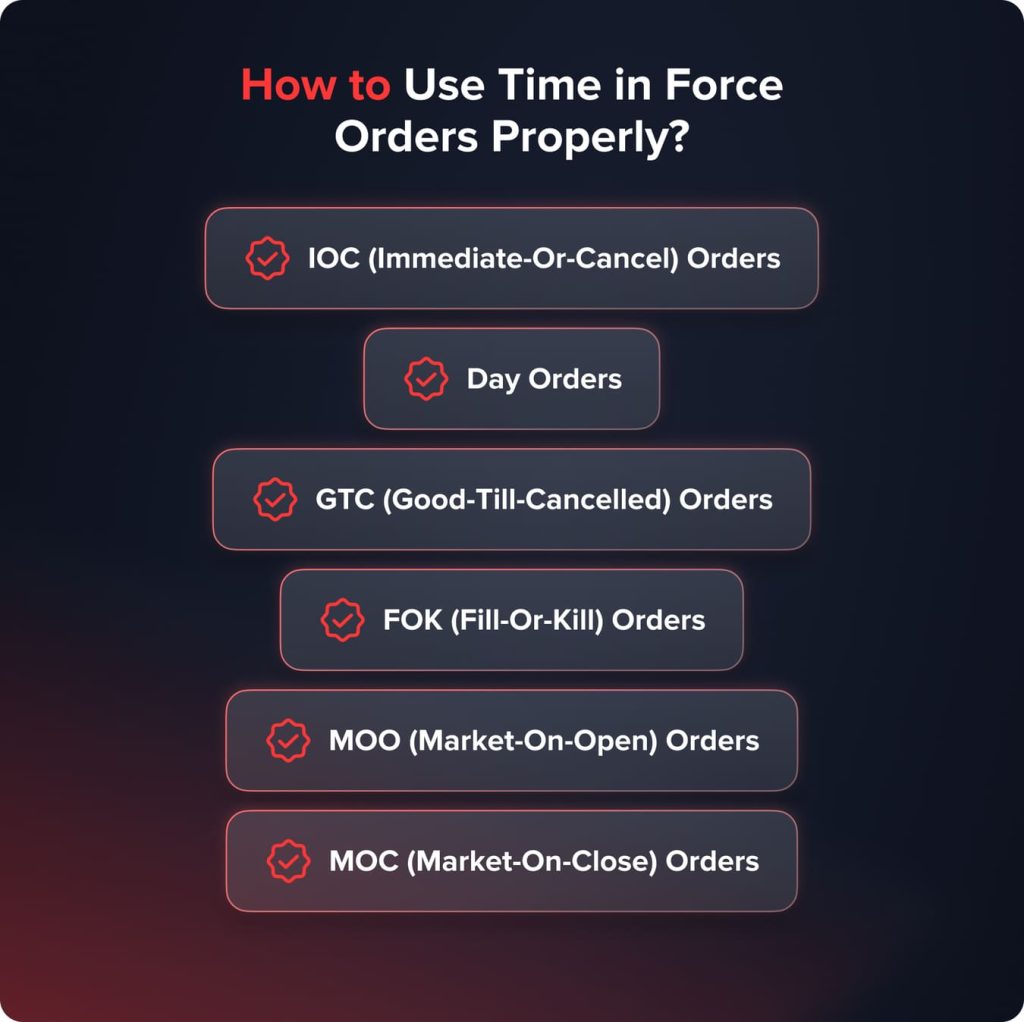
Дневные заказы
Такой тип ордера полезен для внутридневных трейдеров, которые получают возможность открывать позиции по нескольким активам одновременно без необходимости постоянно отслеживать цену актива в течение всего дня.
Внутридневной трейдер проводит глубокий анализ ещё до открытия рынка. Он анализирует каждый актив отдельно, а затем открывает позиции в соответствии с выбранной торговой стратегией.
Таким образом, когда цена актива не достигает необходимого ценового уровня, ордер будет отменен в конце торгового дня.
Приказы МОК (немедленно или отменить)
Инвесторы предпочитают открывать позиции типа «немедленно или отменить», когда им необходимо разместить крупный ордер и избежать его исполнения по разным ценам. Тип IOC означает, что оставшаяся часть ордера, которая не может быть исполнена немедленно, отменяется.
В первую очередь, такой тип ордера полезен на волатильных рынках. Кроме того, ордера IOC широко используются внутридневными трейдерами, открывающими несколько позиций. Ордера типа «немедленно или отмена» минимизируют риски, поскольку трейдеры не забудут отменить позицию до закрытия рынка.
GTC (отмененные до момента оплаты) заказы
Ордера «Good-till-canceled» наиболее полезны для долгосрочных инвесторов. Основываясь на анализе актива, инвесторы определяют уровни цен, по которым они готовы покупать или продавать активы. Чтобы избежать постоянного отслеживания цены актива, инвесторы размещают ордера GTC.
С другой стороны, инвесторам не следует игнорировать риски ордеров GTC. Многие биржи, включая ведущие мировые, понимают, что ордера Good-till-cancelled слишком рискованны для инвесторов; именно поэтому платформы запрещают инвесторам размещать такие ордера. Поэтому брокерские компании продолжают принимать ордера GTC и исполнять их внутри компании. На волатильных рынках резкое движение цены может привести к исполнению ордера GTC, а затем к обратному падению. Инвесторам рекомендуется использовать ордера Good-till-cancelled на рынках, чувствительных к цене, а не на волатильных.
Заказы FOK (Fill-or-kill)
Заказы «выполнить или отменить» являются лучшим выбором для волатильных рынков. Трейдер понимает, что высокие объёмы могут принести большую прибыль, поэтому он размещает крупные ордера. Однако, когда в книге ордеров недостаточно ликвидности для немедленного исполнения крупных ордеров, лучше выйти с рынка.
Ордера FOK помогают инвесторам минимизировать риски и не тратить время на решение мелких задач.
Ордера MOO (Market-on-Open)
Ордера «Market-on-Open» широко используются в новостной торговле. Трейдеры анализируют текущие или предстоящие новости и понимают, что покупка или продажа выбранного актива — оптимальное решение.
Например, в период публикации отчётности подавляющее большинство корпораций раскрывают свои финансовые результаты, когда рынки закрыты. Поэтому резкие колебания цен ожидаются сразу после открытия рынка на следующий день.
С другой стороны, неверные прогнозы могут привести к крупным потерям; поэтому инвесторам нужно быть уверенными, что предстоящее событие существенно повлияет на цену актива.
Ордера MOC (Market-on-Close)
Сферы применения ордеров MOC также связаны с новостной торговлей. Инвестор прогнозирует резкие движения цены после закрытия рынка, связанные с запланированными отчётами или предстоящими важными новостями, и открывает позиции в том же направлении. Ожидая роста цены, трейдер открывает ордер на покупку актива, и наоборот.
Плюсы и минусы приказов о временном прекращении действия
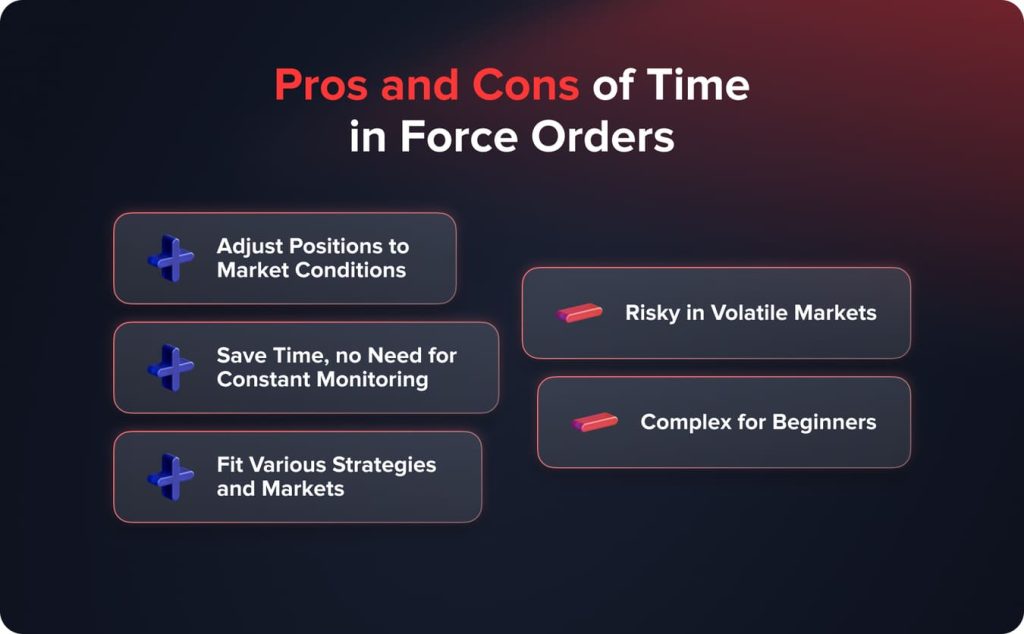
Категория заказов TIF характеризуется следующими преимуществами:
- Ордера TIF расширяют возможности трейдеров, давая им возможность корректировать свои позиции в соответствии с различными рыночными условиями.
- Ордера Time in Force существенно экономят время трейдера, поскольку ему не нужно постоянно отслеживать различные позиции.
- Ордера TIF подходят для различных торговых стилей и стратегий. Кроме того, такие ордера могут использоваться на различных финансовых рынках.
Говоря о недостатках ордеров TIF, отмечают следующие слабые места:
- Ордера «Time in Force» могут создавать дополнительные риски при использовании на волатильных рынках, поскольку резкие движения цен могут привести к исполнению такого ордера, а затем его откату.
- Ордера TIF требуют глубокого анализа и тщательного обдумывания того, какую цену и объемы устанавливать; именно поэтому такие ордера слишком сложны для новичков.
Итог: ордера TIF как вспомогательные инструменты профессионального трейдера
Категория ордеров Time in Force значительно расширяет возможности профессиональных трейдеров. Такие ордера значительно экономят время и минимизируют риски, при этом трейдеру необходимо грамотно проанализировать рынок и установить правильные цены и объёмы.
FAQ
Невозможно выделить наиболее и наименее полезный ордер TIF, поскольку разные типы подходят для разных стилей торговли и рыночных условий.
Ордера IOC и FOK лучше всего использовать на волатильных рынках, поскольку они помогают трейдерам избежать исполнения своих ордеров по разным ценам.
Внутридневные трейдеры часто используют внутридневные ордера, чтобы одновременно отслеживать несколько активов. Кроме того, внутридневные трейдеры могут использовать ордера «немедленно или отменён».
Обновлено:
19 декабря 2024 г.